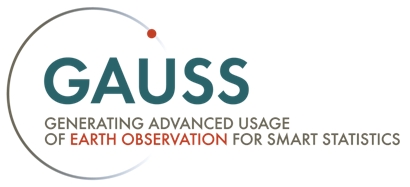GAUSS - Generating Advanced Usage of EO for Smart Statistics


Generating Advanced Usage of Earth Observation for Smart Statistics
Project duration: September 2021 – April 2023
Acronym: GAUSS
Funded by: European Space Agency
Consortium:
National Observatory of Athens (project leader)
Finnish Meteorological Institute
Evenflow
Institute of Geodesy and Cartography, Remote Sensing Centre:
Dr. Eng. Ewa Panek-Chwastyk, e-mail: ewa.panek-chwastyk@igik.edu.pl
Project goal:
It aims is to present the possibility of using satellite data in official statistics in the field of monitoring: air quality, water resources, snow cover, and the range and condition of green areas in individual administrative units. Furthermore, thanks to the close cooperation of the consortium with Statistics Poland, it is possible to present prospects for satellite data for the further development of national statistics in aspects beyond this project's scope.
In response to the needs of national statistical units, the GAUSS project, which is to provide recipients with the most reliable data on society and the environment, aims to develop a methodology for the use of satellite data to create new environmental quality indicators that affect human well-being.
Task description:
National Observatory in Athens will develop a methodology for acquiring atmospheric pollution parameters at the level of local administrative units using high-resolution imaging Sentinel-5P, Copernicus Atmospheric Monitoring Service (CAMS), and local sensor data (AQ).
Finish Meteorological Institute is responsible for a model for monitoring snow cover. It will be developed thanks to Copernicus data and in-situ data from cameras and sensors. In addition, a product
for assessing hydrological drought will also be implemented, based on data from the Sentinel-2 and Jason satellites and on in situ measurements.
Institute of Geodesy and Cartography is responsible for a procedure to assess the quality and extent of green areas at the level of local units based on the Sentinel-2, Copernicus Land Monitoring Service products and ERA-5 reanalysis. It will be a crucial element in assessing welfare in a given commune.
In addition, the project will replicate the air quality and hydrological drought indicators workflows for Poland, confirming the transferability of the methods.
Based on individual case studies, the project will develop recommendations for implementing satellite data into public statistics. They will take into account technical issues and operational and regulatory barriers to the use of satellite products in local statistics.
In summary, the GAUSS project will indicate the possibilities of the operational implementation of satellite data to enrich the databases of European statistical units (Eurostat) with indicators enabling the monitoring of the state of the natural environment.
Official website on GAUSS project is available at the link https://eo4smartstats.com/
Project dissemination:
- Panek E., 2022, Generating Advanced Usage of Earth Observation for Smart Statistics, Earth Observation Forum, 8 - 9 November 2022, Warsaw. PRESENTATION
- Gerasopoulos E., Speyer O., Athanasopoulou E., Arslan A.N., Dąbrowska-Zielińska K., Panek E., Harwood P., Burzykowska A., 2022, GAUSS: Generating Advanced Usage of Earth Observation for Smart Statistics, Living Planet Symposium, 23 - 27 May 2022, Bonn, Germany.
- Panek E., Gerasopoulos E., Dąbrowska-Zielińska K., Arslan A.N, Speyer O., Harwood P., Burzykowska A., 2022, Generating Advanced Usage of Earth Observation for Smart Statistics, The 3rd Congress of Polish Statistics, 26 - 28 April 2022, Krakow, Poland.
